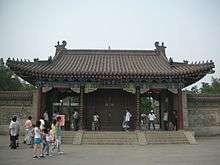Daci'en Temple
| Daci'en Temple | |
|---|---|
| 大慈恩寺 | |
 The Shanmen at Daci'en Temple. | |
 Shown within China | |
| Basic information | |
| Location | Yanta District, Xi'an, Shaanxi |
| Geographic coordinates | 34°13′26″N 108°58′14″E / 34.223942°N 108.970523°ECoordinates: 34°13′26″N 108°58′14″E / 34.223942°N 108.970523°E |
| Affiliation | Buddhism |
| Deity | Yogachara |
| Country | China |
| Architectural description | |
| Architectural style | Chinese architecture |
| Founder | Emperor Gaozong of Tang |
| Funded by | Xuanzang |
| Date established | 648 |
| Completed | 1466 (reconstruction) |
.jpg)
.jpg)
Daci'en Temple (Chinese: 大慈恩寺; pinyin: Dàcí'ēn Sì) is a Buddhist temple located in Yanta District of Xi'an, Shaanxi, China. The temple is the cradle of Yogachara in China.[1] It is notable for the Giant Wild Goose Pagoda. The pagoda was originally built by an accomplished monk Xuanzang, whose story was widespread in civil socity in many dynasties and the famous legendary story Journey to the West was inspired by his experience.[2] Alongside Daxingshan Temple and Jianfu Temple, it was one of the three sutras translation sites (三大译经场) in the Tang dynasty.[3]
History
Located in Jinchangfang (进昌坊) of Chang'an (today's Xi'an), the Daci'en Temple was first constructed in 648, in the 22nd year of Zhenguan period of the Tang dynasty (618–907).[1] Prince Li Zhi, the later Emperor Gaozong of Tang, issued the decree building the temple in commemoration of his mother Empress Zhangsun. The renowned Buddhist monk Xuanzang was in charge of the temple, where he founded the Yogachara in Tang Empire.[2] During his tenure, he handed the construction project of Giant Wild Goose Pagoda.[4]
The temple was rebuilt in 1466, in the reign of Chenghua Emperor in the Ming dynasty (1368–1644).
On March 4, 1961, the temple has been listed among the firs group of the "Major National Historical and Cultural Sites in Shaanxi" by the State Council of China.[5]
In 1983, the temple was authorized as a National Key Buddhist Temple in Han Chinese Area by the State Council of China.
In early 2001, it has been categorized as an AAAA level tourist site by the China National Tourism Administration.
On June 22, 2014, the Giant Wild Goose Pagoda was added to UNESCO's list of World Cultural Heritage.
Architecture
The complex include the following halls: Shanmen, Mahavira Hall, Hall of Four Heavenly Kings, Bell tower, Drum tower, Buddhist Texts Library, Xuanzang Sanzang Hall, Giant Wild Goose Pagoda, Pagodas Forest, etc.
Giant Wild Goose Pagoda
The Giant Wild Goose Pagoda was built by Xuanzang in 652. The 63.25-metre (207.5 ft) pagoda has the brick structure with seven stories and four sides of ancient Indian style. It has been renovated and redecorated several times since the Tang dynasty (618–907).[6][7][4]
Mahavira Hall
The Mahavira Hall enshrining statues of Vairocana, Mahavairocana and Sakyamuni. The two disciples' statues are placed in front of the statue of Sakyamuni, the older is called Kassapa Buddha and the middle-aged is called Ananda. The statues of Eighteen Arhats sitting on the seats before both sides of the gable walls.
Xuanzang Sanzang Hall
The Xuanzang Sanzang Hall (玄奘三藏院) enshrined the Sarira of Xuanzang and copper sitting statue of Xuanzang. On the walls of the hall painted frescos which depicting stories of Xuanzang.
Pagodas Forest
The temple has a history of almost 1400 years, has nine pagodas, which enshrine the Buddhist relics of successive abbots of Daci'en Temple. Their names and birthdates are carved in their pagoda.
National treasure
The temple houses 20 slices of the palm leaf manuscript, which were brought from ancient India by Xuanzang.
References
- 1 2 Zhang Yuhuan (2012), p. 223.
- 1 2 Zi Yan (2012), p. 16–17.
- ↑ "Why Modi visited Daxingshan Temple and Ci'en Temple". Chinadaily. 14 May 2015. Retrieved 26 April 2018.
- 1 2 "Xi'an attractions: Big Wild Goose Pagoda". Chinadaily. 4 March 2011. Retrieved 24 April 2018.
- ↑ 国务院关于公布第一批全国重点文物保护单位名单的通知. sach.gov.cn (in Chinese). 2010.
- ↑ Liang Sicheng (2005), p. 122.
- ↑ Zhang Yuhuan (2012), p. 224–225.
Bibliography
- Zi Yan (2012). Famous Temples in China (in English and Chinese). Hefei, Anhui: Huangshan Publishing House. ISBN 978-7-5461-3146-7.
- Zhang Yuhuan (2012). "Cradles of Yogachara: Xi'an Daci'en Temple" 《法相宗祖庭:西安大慈恩寺》. 《图解中国佛教建筑》 [Illustration of Buddhist Architecture in China] (in Chinese). Beijing: Contemporary China Publishing House. ISBN 978-7-5154-0118-8.
- Liang Sicheng (2005). "Giant Wild Goose Pagoda in Ci'en Temple" 《慈恩寺大雁塔》. 《中国建筑史》 [Architecture History in China] (in Chinese). Heping District, Tianjin: Baihua Literature and Art Publishing House. ISBN 7-5306-4168-9.